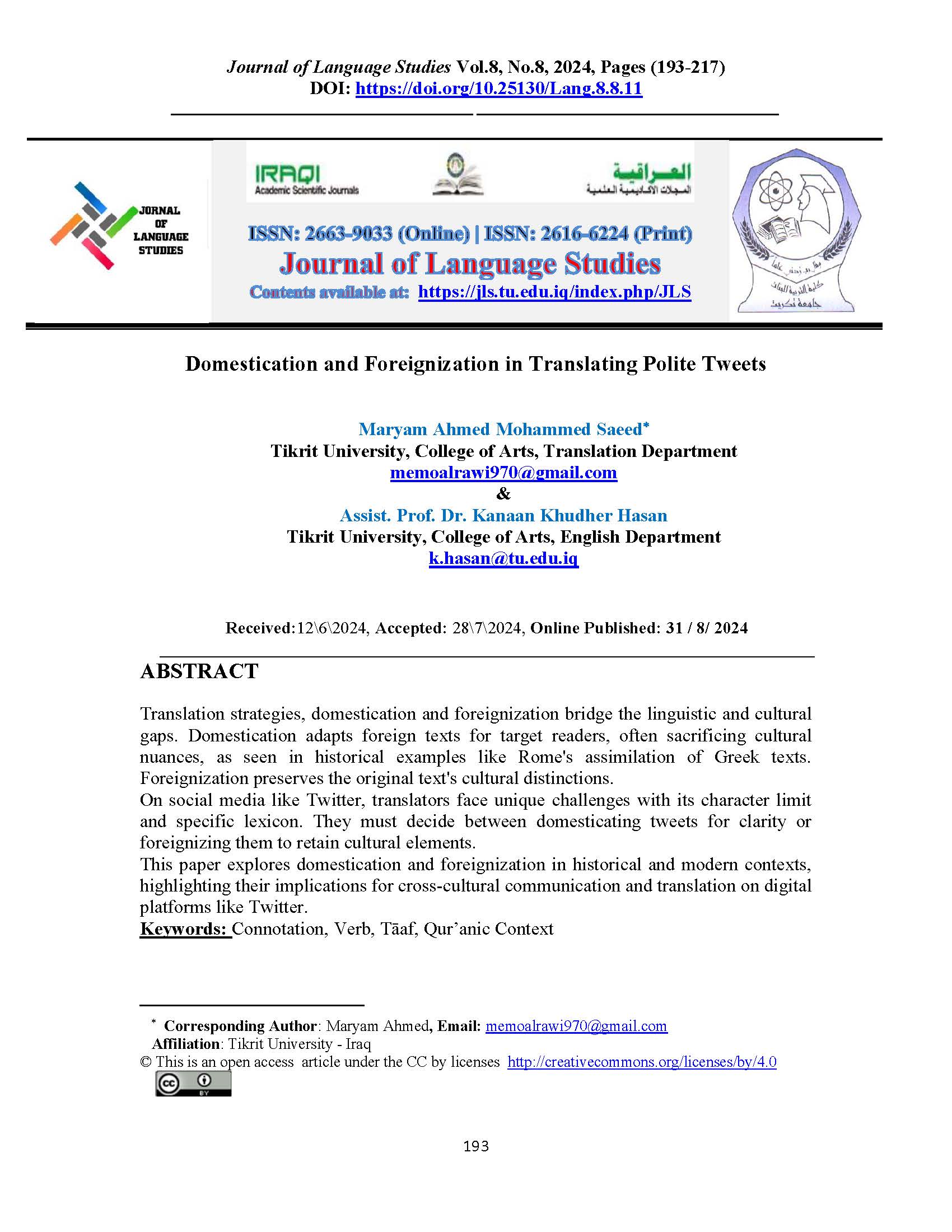Domestication and Foreignization in Translating Polite Tweets
DOI:
https://doi.org/10.25130/Lang.8.8.11Keywords:
Connotation, Verb, Tāaf, Qur’anic ContextAbstract
Translation strategies, domestication and foreignization bridge the linguistic and cultural gaps. Domestication adapts foreign texts for target readers, often sacrificing cultural nuances, as seen in historical examples like Rome's assimilation of Greek texts. Foreignization preserves the original text's cultural distinctions.
On social media like Twitter, translators face unique challenges with its character limit and specific lexicon. They must decide between domesticating tweets for clarity or foreignizing them to retain cultural elements.
This paper explores domestication and foreignization in historical and modern contexts, highlighting their implications for cross-cultural communication and translation on digital platforms like Twitter.
References
Abderraouf, C. H. O. U. I. T. (2019). A critical evaluation of Venuti’s domestication and foreignization theory of translation. Traduction et Langues 18 (1), 101-116.
Adegbija, E. (1989). A comparative study of politeness phenomena in Nigerian English, Yoruba and Ogori. Journal of pragmatics, 13 (3), 347- 371.
Agarwal, A., Xie, B., Vovsha, I., Rambow, O., & Passonneau, R. J. (2011, June). Sentiment analysis of twitter data. In Proceedings of the workshop on language in social media (LSM 2011) (pp. 30-38).
Baker, M. (Ed.). (1998). Encyclopedia of Translation Studies. London and New York: Routledge.
Brown, P. (1980). How and why are women more polite: Some evidence from a Mayan community. In Women and language in literature and society (pp. 111-136). Praeger.
Brown, P., & Levinson, S. C. (1987). Politeness: Some universals in language usage (Vol. 4). Cambridge university press.
Crystal, D. (2003). A Dictionary of Linguistics and Phonetics 6th. Edition. London: Blackwell publishing Ltd.
Eelen, G. (2001). A critique of politeness Theories. Manchester: St. Jerome publishing.
Gile, D. (2009). Basic concepts and models for interpreter and translator training. Basic Concepts and Models for Interpreter and Translator Training, 1-299.
Goffman, E. (1967). Interaction Ritual: Essays in Face-to-face Behavior. Aldine Publishing Company.
Gutt, E. A. (1998). Pragmatic aspects of translation: Some relevance-theory observations. In The pragmatics of translation (pp. 41-53).
Holmes, J. (2008). An Introduction to Sociolinguistics. 3td. Edition London: Person.
Huang, Y. (2007). Pragmatics.
Lakoff, R. (1972). “Language in context”. In Journal of the Linguistic Society of America, 48(4), 907- 927.
Li, M., Hickman, L., Tay, L. Vngar, L. & Guntuku, S. c. (2020). Studying politeness across Cultural Using English Twitter and Mandarin Weibo. Proceeding of the ACM on human- computer interaction, 4 (cscw2), 1-15.
Munday, J. (2001). Introducing Translation Studies: Theories and Applications. London and New York: Routledge.
Nida, E. A. (2000). Language, Culture and Translation. Shanghai: Shanghai Foreign Language Press.
Nida, E. A., & Waard, J. (Eds.). (1986). From One Language to Another: Functional Equivalence in Bible Translation.
Pew Research Center. (2009, October 21). Portrait of a Twitter user: Status Update Demographics. Pew Research Center: Internet, Science & Tech.
Sapitri, P. A., Chasanah, A., Putri, A. A., & Paulima, J. (2019). Exploring Brown and Levinson's Politeness Strategies: An Explanation on the Nature of the Politeness Phenomenon. REiLA: Journal of Research and Innovation in Language, 1(3), 111-117.
Shuttleworth, M., & Cowie, M. (2004). Dictionary of translation studies. United Kingdom: Routledge.
Shuttleworth, M., & Cowie, M. (2014). Dictionary of translation studies. Routledge.
Suzila, T. T. I., & Yusri, M. M. (2012). Politeness: Adolescents in disagreements. International Journal of Social Science and Humanity, 2(2), 127.-132.
Tan, Z. (1991). A Brief History of Western Translation. Beijing: commercial press.
Thomas, J. (1995). Meaning in interaction. An introduction to pragmatics.
Venuti, L. (1995). The translator's invisibility: a history of translation.
Venuti, L. (1998). The Scandals of Translation-by Lawrence Venuti. pedagogy, 67, 5.
Venuti, L. (2004). The Translator's Invisibility: A History of Translation. Shanghai: Shanghai Foreign Language Education Press.
Venuti, L. (2008). The Translator's Invisibility: A History of Translation. London and New York: Routledge.
Victoria (2009) Power and politeness: a study of social interaction in business meetings with multicultural participation.
Yule, G. (2010). The study of language 4th edition. Cambridge: Cambri Carlisle, JF (2010). Effects of Instruction in Morphological Awareness on Literacy.

